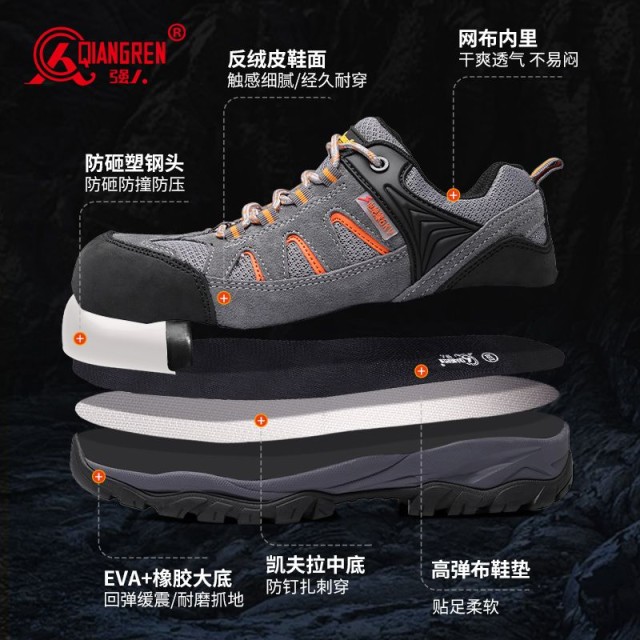Every day, workers in construction, manufacturing, and oil rigs face threats that could cripple their most vital tools—their feet. With 26 bones and 38 joints per foot, even minor workplace hazards can lead to catastrophic injuries. This article reveals how purpose-built work boots address anatomical vulnerabilities through scientifically validated designs.
Why Foot Anatomy Demands Specialized Protection
The Fragility of 26 Bones and 38 Joints
Your feet bear the weight of your entire body while navigating uneven terrain, heavy machinery, and falling objects. The metatarsals (long foot bones) and phalanges (toe bones) are particularly prone to fractures from impacts. Research shows that:
- Crush injuries from dropped tools account for over 40% of foot traumas in industrial settings.
- Lateral ankle sprains caused by slips often damage the talus and calcaneus (heel bone).
Common Injury Scenarios in Risk-Bearing Industries
- Construction: Falling rebar or lumber can fracture toes instantly.
- Manufacturing: Chemical spills degrade skin and soft tissues.
- Oil/Gas: Slick surfaces lead to torsion injuries in ankle joints.
Work boots aren’t just accessories—they’re engineered solutions to these anatomical risks.
Key Features of Work Boots That Mitigate Risks
1. Toe Caps and Metatarsal Guards: Shielding Critical Bones
ASTM F2413-certified boots use two protective technologies:
- Steel toes: Absorb up to 75% of impact energy from 50+ pound objects.
- Composite toes: 30% lighter than steel and ideal for temperature extremes (e.g., foundries or cold storage).
Case in point: Oil rig workers wearing metatarsal guards report 60% fewer foot fractures from pipe drops.
2. Shock Absorption and Arch Support: Protecting Joints
- Polyurethane midsoles reduce ground force reactions by 20–30%, sparing knee and hip joints.
- Contoured footbeds align the plantar fascia ligament to prevent chronic conditions like plantar fasciitis.
3. Slip-Resistant Soles: Preventing Traumatic Falls
Boots with microgrooved rubber outsoles increase traction by 50% on oily surfaces (per ASTM F2913 tests). This prevents the sudden twists that tear ankle ligaments.
Industry-Specific Boot Requirements
| Industry | Primary Threats | Boot Features |
|---|---|---|
| Construction | Falling objects, nails | Steel toes, puncture-resistant soles |
| Manufacturing | Chemical burns, spills | EH-rated insulation, acid-proof uppers |
| Oil/Gas | Slippery decks, heavy loads | Non-sparking composites, ankle support |
Proven impact: A 2022 study found that rig crews using ASTM-compliant boots reduced slip-related injuries by 45%.
Step Into Safety with 3515’s Anatomically Engineered Boots
Your workforce’s feet face relentless hazards—but the right boots transform vulnerability into resilience. 3515 designs certified safety footwear that combines ASTM-tested protection with ergonomic comfort. For distributors and bulk buyers, our customizable work boots ensure every step is guarded against fractures, shocks, and slips.
Ready to upgrade your team’s foot defense? Partner with 3515 to equip them with boots built for survival.
Related Products
- Wholesale Customizable Suede Safety Boots - Puncture-Proof with Velcro Closure
- Puncture-Resistant Velcro Safety Boots for Wholesale & Custom Manufacturing
- Customizable Anti-Smash Safety Boots for Wholesale & Private Label Manufacturing
- Athletic Safety Shoes with Dial Closure & Steel Toe for Wholesale & Custom Manufacturing
- Wholesale Classic Leather Lace-Up Ankle Boots for Brand Manufacturing
Related Articles
- How to Choose Work Boots That Balance Safety, Comfort, and Durability for Your Job
- Steel Toe Work Boots: Balancing Safety and Comfort for Demanding Jobs
- How to Choose Work Boot Materials for Maximum Safety and Durability
- Work Boots vs. Western Boots: How to Choose the Right Footwear for Labor Safety
- How Safety Work Boots Engineer Protection: Features and Standards for Targeted Hazard Mitigation



















